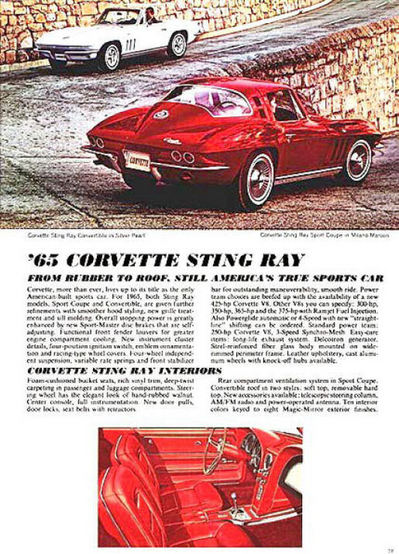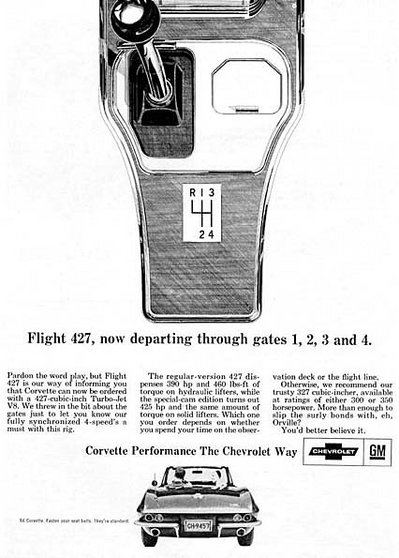Corvette History Through Ads: Performance Advertising Makes a Comeback
Corvette History Through Ads
Performance Advertising Makes a Comeback
By Rick Tavel ?All rights reserved
The first two years of the C2 Corvette, advertising focused on the car’s comfort and convenience options, frequently depicting the car as more of a personal luxury car than a performance car. Coupled with the new coupe’s heavy advertising bias, little money was left in the budget to highlight the Corvette’s performance capabilities. But by 1965 the advertising balance between the personal-luxury Corvette and the performance Corvette began to return and in 1966 the emphasis shifted back to the Vette’s performance capabilities.
Advertising priorities shifted because of the growing interest in muscle and performance cars sweeping the country. Though GM offered several muscle cars, they realized that none was as potent as the Corvette. So in 1965 GM began stuffing their powerful big block engines into the sports car, starting with their 425 HP 396 cubic inch Turbo-Jet. To harness the power, the Muncie M22 Rock-crusher transmission became a special order option. Disc brakes were standardized to stop the Corvette effectively.
As mentioned, advertising in 1966 emphasized the Corvette’s performance and consequently the 1966 model year sold nearly 20% more second-gen Corvettes than any other year C2, selling 27,720 cars. The focus on improved engine, transmission, brake, and suspension performance were the key reasons for the model year’s outstanding sales results. That same model year was the first to offer the renowned 427 cubic inch engine, the 390 HP L36 and the 425/450HP L72. Originally GM promoted the L72 engine as having 450 HP and then, just before production, began an Engineering Change Recommendation (ECR) lowering the stated 450 HP rating to 425 HP. Though it caused confusion from customers, in reality, the only difference between the engines was cars ordered after the ECR had a ?425HP? sticker on the air cleaner. Also that year Holley carburetors became standard equipment on all Corvette engines.
Most muscle and American car enthusiasts have at least heard of the legendary Rock-crusher manual transmission offered in the mid to late 1960’s and early 1970’s. Designated by the RPO M22 it was produced by Muncie and first offered as a regular production option for the Corvette in 1966 model year. The transmission was available only by special order the year before. There are two opinions on how the transmission got its nickname. The first is because the transmission is equipped with gears that are cut much straighter (but not totally straight cut) than normal, and produces an industrial sounding whine that many enthusiasts love. The second opinion holds that it wasn’t so much from its noise but rather because it was virtually indestructible, ie you could put rocks inside it and it would crush them.
What some street and drag racers don’t know is that the M22 was engineered and built to for road racing because they generated less heat during extended racing due to the straighter gear cut and the use of an aluminum case. Though the Rock-crusher has become something of an urban legend, by today’s standards it is outdated. Even so, the Muncie M22 was an outstanding transmission in its era and even today is considered one of the top five best factory transmissions ever produced.
Officially, GM production records show that a total of only 371 M22 transmissions were installed in the 157,125 Corvettes produced from 1966 through 1971, the last year the heavy duty transmission was offered as a RPO in GM’s sports car. Just .2%, the small number is indicative of just how much the urban legend has grown over time.


